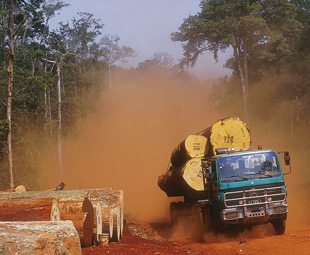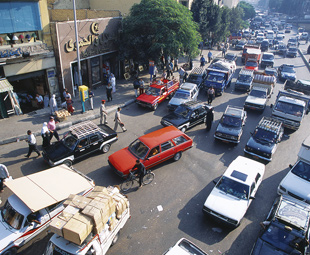Africa: stuck in the dark ages?

There is an age-old belief that Africa is stuck in the dark ages. When it comes to transport, is that a fair assumption? GERHARD HORN ponders…
We all know the picture. An ancient truck, barely held together by faith and dust, drives past on a rural dirt road somewhere in Africa. On the back we find hundreds of people holding on for dear life. The luggage is stacked beyond the boundaries of the truck itself and the people are neatly stacked on top of said luggage. Some passengers hang nonchalantly from the side, not bothered that the rope holding the whole thing together could snap any second.
Think of the words “Africa” and “transport”. This is inevitably the first image that comes to mind; hundreds of people on the back of a truck going somewhere slowly. It may not be glamorous or fast, but it’s better than walking and faster than packing a donkey. In Africa, necessity is definitely the mother of all invention.
This picture, however funny it may be, creates the false assumption that Africa is still stuck in the dark ages. Across the pond people seem to think that we worship the camel for being modern and economical. Why is this?
The first documented, mass-scale transport operation in Africa was the Trans-Atlantic Slave Trade. It lasted from the 16th to the 19th century in some form or other. Historians, conservatively we might add, estimate that around 12 million people were taken from Africa to become slaves in the “new world.”
This would have a massive influence on the way Africa developed over the years. It certainly was not the only thing holding back the development of Africa, but it certainly created a large gaping hole in the population.
This redistribution of people was the first of many moments in time that lead to Afro-pessimism. This is the notion that the future of Africa is bleak because of the multitude of problems faced by the continent. In layman’s terms; we’re far behind the rest of the world.
Complete and utter nonsense, we say. Africa may not have the latest and greatest, but we’re definitely way past the age of camels. Africa’s transport system has been kept alive by ingenuity. Most vehicles on the road may be old and falling apart, but it is the way we keep them alive that is really impressive.
Take the taxi as an example. To a foreigner a taxi is a four-door saloon, painted in some sort of yellow colour. They can collect you straight from your home, or you can catch them as they drive past. They are a dependable, but expensive means of getting where you need to be.
Compare that to Africa’s version of the taxi. It will almost certainly be a minibus. Usually, about 50% more people than is strictly legal will be squished in the back. The wheels are bent outwards and the only thing keeping it going are the prayers of those inside.
It is strange then that such a big part of the economy relies on this system working efficiently. Just think of the millions of people who use taxi transport to get to work. Then imagine the removal of the only means of transport for all these people. The economy will surely collapse within days.
Still, ask any average road user what he thinks about taxis and the answers will vary from obnoxious to downright dangerous. It is true that some of them have no respect for the rules of the road, but it would be wrong to subscribe to this stereotype.
 The public transport system is, however, not limited to taxi transport. Africa is filled to the brim with trains, buses, flatbed trucks and friendly people with space for one more in their car. Let us just be honest for a second though. They are nowhere near as sophisticated as their counterparts on the other side of the sea, but the good news is that we are definitely getting there.
The public transport system is, however, not limited to taxi transport. Africa is filled to the brim with trains, buses, flatbed trucks and friendly people with space for one more in their car. Let us just be honest for a second though. They are nowhere near as sophisticated as their counterparts on the other side of the sea, but the good news is that we are definitely getting there.
In South Africa alone there has been massive improvement in the past 10 years. Car sales have improved dramatically, except for the small worldwide glitch in 2009. More cars mean more people on the road and so the infrastructure had to be improved as well. This is nothing compared to the giant leaps made in the public transport sector. The Bus Rapid Transport system has been successfully implemented and is working well with the systems already in place.
The biggest news is the brand new Gautrain. Although not strictly on wheels, it is still impressive even when measured against the rest of the world. This is a good example of the way Africa is perceived in these modern times. No longer is it merely a hindrance between America and Australia, but a good solid investment opportunity if you are looking for one.
Government’s Motor Industry Development Programme played a huge roll in the growth of the economy. The programme was introduced in 1995 and will reach its final phase in 2012. It has done what it was supposed to. The major vehicle manufacturers are all represented in South Africa. Three of the four largest tyre manufacturers can also be found here. Investment in South Africa’s automotive industry totaled R6,2 billion in 2006. The list of auto manufacturers in South Africa includes Ford, General Motors, Mercedes-Benz, Toyota and Volkswagen. Volkswagen only recently invested more than R200 million on a new parts and distribution centre in South Africa.
At the moment, Africa is the sole supplier of the Volkswagen Crosspolo to all world markets. Africa can also be proud of the fact that we exclusively build all right-hand drive, four-door Polos for the entire planet. At the end of 2010 the export figure will hopefully stand at 75 000.
This is good news, not only for South Africa, but the entire continent. Investors across the globe will see that Africa is full of untapped potential. We have the people, the will and the never-say-die attitude to make a success of anything.
Africa has even become advanced enough to be a valid competitor to the emissions free crowd. A small company called Optimal Energy has developed an all-electric vehicle named Joule.
Optimal Energy claims that it is a “standard five-seater that complies with UN-ECE safety standards offering an optimal, no-compromise, and zero emission urban driving experience.” Only a few other countries can claim to have something as impressive as that.
Joule was developed from the outset as an electric vehicle. As such, it offers all the positive attributes of an electric vehicle, while still adhering to the norms associated with family motoring. The fact that it has a claimed range of 300 km is a mere added bonus.
If nothing else, Africa has proven that Afro-pessimism, as a concept, is as outdated as the carburettor. It may not be as technologically advanced as some first world countries and sure, there are still a few dictators here and there, but overall it is going well. People are easily scared by the Dark Continent because of our propensity to do things a bit differently. It goes with the territory I’m afraid. We have a saying over here and every African knows it by heart: “Africa, it’s not for sissies.”
Believe it.
Published by
Focus on Transport
focusmagsa


 Big news from FOCUS on Transport + Logist
Big news from FOCUS on Transport + Logist


 !
Starting 1 April, every
!
Starting 1 April, every


 FUSO: Driving the Future of Mobile Healthc
FUSO: Driving the Future of Mobile Healthc



 A brand
A brand




 Wondering about the maximum legal load for a
Wondering about the maximum legal load for a 
 The MAN hTGX powered by a hydrogen combus
The MAN hTGX powered by a hydrogen combus

 Exciting News for South African Operators
Exciting News for South African Operators


